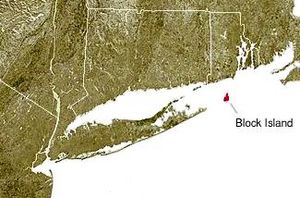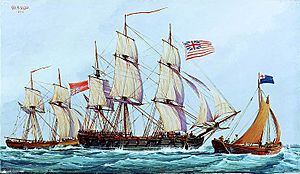Battle of Block Island facts for kids
Quick facts for kids Battle of Block Island |
|||||||
|---|---|---|---|---|---|---|---|
| Part of the American Revolutionary War | |||||||
 USS Alfred being prepared for her maiden voyage |
|||||||
|
|||||||
| Belligerents | |||||||
| Commanders and leaders | |||||||
| Strength | |||||||
| HMS Glasgow | 7 ships | ||||||
| Casualties and losses | |||||||
| 1 killed 3 wounded |
10 killed 14 wounded |
||||||
The Battle of Block Island was a naval fight during the American Revolutionary War. It happened in the waters near Rhode Island. The Continental Navy, led by Commodore Esek Hopkins, was sailing back from a successful mission. They had just raided Nassau when they met HMS Glasgow. This was a British Royal Navy ship carrying important messages.
The Glasgow managed to get away from the American fleet of seven ships. However, it was badly damaged. Because the British ship escaped, this battle is seen as a victory for the British. Several American captains were criticized for how they acted during the battle. One captain was even removed from his job. Commodore Hopkins also faced criticism for other actions. He was later dismissed from his role.
Why the Battle Happened
HMS Glasgow was a 20-gun frigate (a type of warship) of the Royal Navy. In early April 1776, Captain Tryingham Howe commanded it. The ship was carrying secret messages from Newport, Rhode Island, to the British fleet. This British fleet was off Charleston, South Carolina. They were planning an attack on Charleston. That attack later failed in June 1776.
The Second Continental Congress created the Continental Navy in late 1775. By February 1776, the first ships were ready to sail. Commodore Esek Hopkins was chosen to lead eight ships. Their mission was to go to the Bahamas. The British were known to have military supplies there. In early March, the American fleet landed soldiers on New Providence island. They captured the town of Nassau.
The fleet sailed north on March 17. They now had two captured ships, called "prizes." These ships were full of stolen military supplies. One ship was sent to Philadelphia. The rest of the fleet sailed towards the Block Island channel. Many sailors on the fleet's journey got sick. Diseases like fevers and smallpox spread. This made it harder for the crews to do their jobs.
By April 4, the fleet reached the waters near Long Island. They captured HMS Hawk, which also carried supplies. The next day, they captured a second prize ship called the Bolton. Hopkins kept sailing near Block Island that night. He hoped to capture more easy prize ships. He set up his fleet in two lines for scouting. The right line was led by USS Cabot. Behind it was Hopkins' main ship, USS Alfred. The Alfred had 20 guns and was the biggest ship.
The left line was led by the USS Andrew Doria. Behind it was USS Columbus. Then came USS Providence. USS Fly and USS Wasp followed further back. They were protecting the captured prize ships. The need to put sailors on the prize ships made the American fleet less ready for a fight.
The Battle Begins
The battle happened on a very clear night. The moon was almost full. USS Andrew Doria and HMS Glasgow saw each other. This was between 1:00 and 2:00 am on April 6. They were about 20 to 24 nautical miles southeast of Block Island. The American fleet was sailing south. The Glasgow was heading west towards Charleston.
Captain Howe of the Glasgow turned his ship around. He wanted to check out the American fleet. Over the next 30 minutes, he got close enough to shout to them. Commodore Hopkins did not give any signals during this time. So, the American fleet did not form a battle line. Captain Nicholas Biddle of the Andrew Doria later called the battle "helter-skelter." This means it was very disorganized.
Howe's ship, the Glasgow, first met USS Cabot. The Cabot was commanded by John Hopkins, Commodore Esek Hopkins' son. The Glasgow called out to the Cabot to ask who they were. John Hopkins replied, "The USS Columbus and USS Alfred, a 22-gun frigate." Then, a sailor on the Cabot threw a grenade onto the Glasgow's deck. This started the fight.
The Cabot, a smaller ship, fired its cannons. But its shots did not do much damage. The Glasgow fired back with two powerful shots from its heavier guns. These shots killed the Cabot's master. They also wounded John Hopkins and broke the ship's steering. As the Cabot drifted away, USS Alfred came forward to fight the Glasgow. The two ships began to fire their cannons at each other.
Early in the fight, a shot from the Glasgow broke the steering lines of the Alfred. This made the Alfred lose control and drift. It also made it hard for Biddle's Andrew Doria to join the fight. The Andrew Doria had to move to avoid the drifting Cabot. USS Providence stayed back. USS Columbus joined the battle late. But its shots were so wild that they barely hit the Glasgow.
However, the Glasgow was now being shot at by three American ships. Captain Howe decided to stop fighting. He wanted to avoid his ship being boarded by American sailors. He set his sails and sped away towards Newport. The Glasgow had a lot of damage to its sails and ropes. But it still pulled away from the American fleet. The American ships were slower because they were full of captured goods. Hopkins stopped chasing the Glasgow after several hours. He wanted to avoid meeting the British ships waiting at Newport. The only thing he captured was a small boat that belonged to the Glasgow. The American fleet brought it to New London, Connecticut, on April 8.
What Happened Next
HMS Glasgow had one sailor killed and three wounded. This low number of casualties suggests that the American fleet's gunnery (shooting skills) might not have been very good. All the injuries on the Glasgow were from musket fire. On the American side, four sailors were killed and seven wounded on the Cabot. USS Alfred had six killed and six wounded. A drummer on the Andrew Doria was also wounded.
John Hancock, who was the President of the Continental Congress, praised Hopkins. He liked how the fleet had performed overall. But the fact that they failed to capture the Glasgow gave people a reason to criticize the Navy. Captain Nicholas Biddle wrote that the battle was "A more imprudent, ill-conducted affair never happened."
Captain Abraham Whipple of USS Columbus was accused of being a coward. He later asked for a special military trial to clear his name. On May 6, 1776, a group of officers from the cruise found Whipple not guilty of cowardice. However, they did say he made mistakes in his decisions. Captain John Hazard of USS Providence was not as lucky. His own officers accused him of many things. These included not doing his duty during the Glasgow battle. He was found guilty by a military court and had to leave the Navy.
Commodore Hopkins also faced problems from Congress. These were not about the Block Island battle. He had not followed his written orders to sail to Virginia and the Carolinas. Instead, he went to Nassau. He also gave away the goods captured during the trip in Connecticut and Rhode Island. He did this without asking Congress first. He was officially criticized for these actions.
Many of the American fleet's ships did not have enough crew members. They also got stuck in Providence, Rhode Island. This happened because the British took over Newport in late 1776. So, these ships could not sail again. In January 1778, Hopkins was removed from the Navy.
HMS Glasgow returned to Newport. It was damaged from the battle and had to throw away its secret messages. The ship was in bad shape. It was made safe enough to sail and sent to Portsmouth for repairs. Another British ship, HMS Nautilus, took over its mission.
See also
- American Revolutionary War §Early Engagements. This section helps you understand where the Battle of Block Island fits in the larger war.



